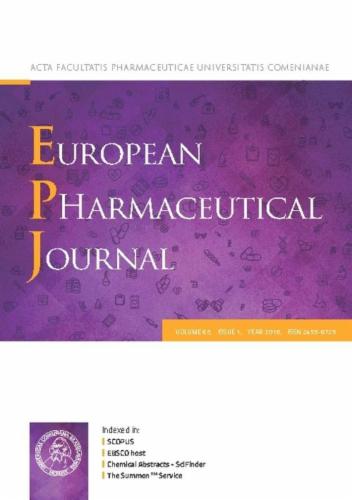磷脂酰基链长度调节:一种增强疏水性细菌素微球菌蛋白P1向生物膜的脂质体药物递送的策略。
IF 4.3
3区 医学
Q1 PHARMACOLOGY & PHARMACY
引用次数: 0
摘要
本研究描述了作为疏水抗菌肽微球菌蛋白P1 (MP1)的药物递送系统的融合性脂质体的发展。脂质体是用不同酰基链长度的磷脂配制的,目的是提高生物膜的根除。两个月的液相色谱-质谱监测表明,将MP1包埋在脂质体中可以有效地提高其在溶液中的稳定性。脂质体包埋使MP1对几种金黄色葡萄球菌菌株(包括临床分离株)的最低抑制浓度降低了4- 16倍。增加脂质体组成中磷脂酰基链长度(从16碳到20碳),不仅可以改善MP1的包裹,而且可以提高抗生物膜活性。共聚焦激光扫描显微镜成像显示,mp1负载的脂质体效应可能是由于生物膜基质的破坏。在0.25µg/mL浓度下,MP1装载在1,2-二硝基二硝基-森-甘油-3-磷酸胆碱(DAPC)基的fusogenic lipo质体中,使生物膜细胞活力降低了约55%,而与之相比,自由MP1等量物仅降低了15%。然而,通过较长的酰基链增加的脂质体双层疏水性损害了促聚变脂质体的物理稳定性。而基于较短的16碳酰基链1,2-二棕榈酰-森-甘油-3-磷脂胆碱(DPPC)的mp1脂质体可以稳定两个月,而DAPC脂质体只能稳定两周。将阳离子磷脂1,2-二油基-3-三甲基丙烷(DOTAP)的浓度从25 mol%增加到50 mol%,提高了脂质体的物理稳定性。总的来说,这些发现突出了脂质体系统将疏水性肽(如MP1)递送到金黄色葡萄球菌生物膜的潜力,为改善生物膜相关感染的治疗提供了希望。本文章由计算机程序翻译,如有差异,请以英文原文为准。
Phospholipid acyl chain length modulation: a strategy to enhance liposomal drug delivery of the hydrophobic bacteriocin Micrococcin P1 to biofilms
This study describes the development of fusogenic liposomes as a drug delivery system for the hydrophobic antimicrobial peptide micrococcin P1 (MP1). The liposomes were formulated using phospholipids with varying acyl chain lengths, with the goal of improving biofilm eradication. Entrapment of MP1 in liposomes effectively improved its stability in solution, as demonstrated by liquid chromatography-mass spectrometry monitoring over a two-month period. Liposomal entrapment lowered the minimum inhibitory concentration of MP1 against several Staphylococcus aureus strains, including clinical isolates, by 4- to 16-folds. Increasing the phospholipid acyl chain length (16-carbon to 20-carbon) in the liposomal composition, resulted not only in an improved entrapment of MP1, but also higher antibiofilm activity. Confocal laser scanning microscopy imaging revealed that the MP1-loaded liposomal effect was likely due to disruption of the biofilm matrix. At a concentration of 0.25 µg/mL, MP1 loaded in 1,2-diarachidoyl-sn‑glycero-3-phosphocholine (DAPC)-based fusogenic liposomes reduced biofilm cell viability by approximately 55 %, compared to only 15 % with free MP1 equivalents. However, the increased liposomal bilayer hydrophobicity via the longer acyl chains compromised the physical stability of the fusogenic liposomes. While MP1-loaded liposomes based on the shorter 16-carbon acyl chain 1,2-dipalmitoyl-sn‑glycero-3-phosphocholine (DPPC) remained stable for two months, the DAPC liposomes were only stable for two weeks. The physical stability was improved by increasing the concentration of the cationic phospholipid, 1,2-dioleoyl-3-trimethylammonium-propane (DOTAP), from 25 mol % to 50 mol % in the liposomal composition. Overall, these findings highlight the potential of liposomal systems for delivering hydrophobic peptides like MP1 to Staphylococcus aureus biofilms, offering promise for improving the treatment of biofilm-associated infections.
求助全文
通过发布文献求助,成功后即可免费获取论文全文。
去求助
来源期刊
CiteScore
9.60
自引率
2.20%
发文量
248
审稿时长
50 days
期刊介绍:
The journal publishes research articles, review articles and scientific commentaries on all aspects of the pharmaceutical sciences with emphasis on conceptual novelty and scientific quality. The Editors welcome articles in this multidisciplinary field, with a focus on topics relevant for drug discovery and development.
More specifically, the Journal publishes reports on medicinal chemistry, pharmacology, drug absorption and metabolism, pharmacokinetics and pharmacodynamics, pharmaceutical and biomedical analysis, drug delivery (including gene delivery), drug targeting, pharmaceutical technology, pharmaceutical biotechnology and clinical drug evaluation. The journal will typically not give priority to manuscripts focusing primarily on organic synthesis, natural products, adaptation of analytical approaches, or discussions pertaining to drug policy making.
Scientific commentaries and review articles are generally by invitation only or by consent of the Editors. Proceedings of scientific meetings may be published as special issues or supplements to the Journal.

 求助内容:
求助内容: 应助结果提醒方式:
应助结果提醒方式:


